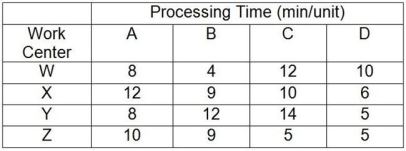Table 5.2
A company makes four products that have the following characteristics: Product A sells for $75 but needs $20 of materials and $20 of labor to produce; Product B sells for $90 but needs $45 of materials and $20 of labor to produce; Product C sells for $110 but needs $50 of materials and $30 of labor to produce; Product D sells for $135 but needs $75 of materials and $40 of labor to produce. The processing requirements for each product on each of the four machines are shown in the table.

Work centers W, X, Y, and Z are available for 40 hours per week and have no setup time when switching between products. Market demand is 50 As, 60 Bs, 70 Cs, and 80 Ds per week. In the questions that follow, the traditional method refers to maximizing the contribution margin per unit for each product, and the bottleneck method refers to maximizing the contribution margin per minute at the bottleneck for each product.
-Use the information in Table 5.2. Using the bottleneck method, what is the optimal product mix?
Definitions:
Nutrient-Dense Foods
Foods that have a high amount of nutrients but relatively few calories, emphasizing the quality of the nutrients they contain.
Empty Calories
Calories from food containing little to no nutritional value, often from added sugars and solid fats.
Portion Sizes
The specific amount of food or drink that is considered appropriate for one individual consumption.
Recommended Caloric Intake
The amount of calories a person should consume daily based on their age, gender, and activity level to maintain good health.
Q14: Better forecasting processes yield better forecasts.
Q28: A planning horizon is defined as the
Q53: What information would managers use to choose
Q56: The process structure that best describes a
Q71: Which one of the following statements is
Q72: It would be most appropriate to combine
Q107: In a lean system,the key to continuous
Q148: Quality at the source refers to the
Q181: Which of the following would be a
Q196: _ automation can handle various products through